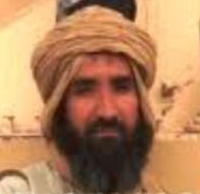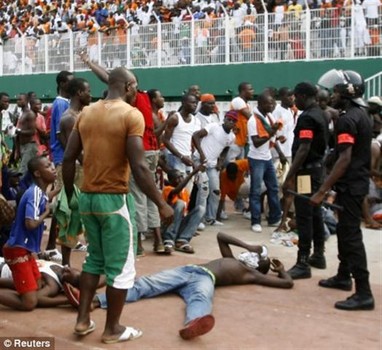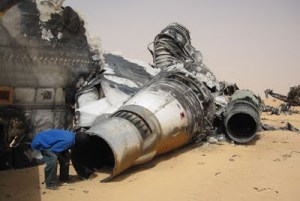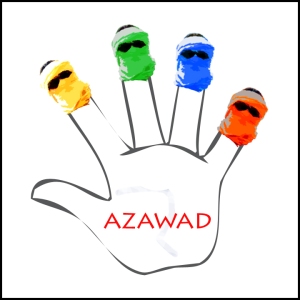First Published: 12 July 2012. Updated: 8 February 2013
MNLA (National Movement for the Liberation of Azawad)
The MNLA is a very recent organisation with a very old cause: the Tuareg have been fighting an insurgency against the central power in Mali since the late 1950s and openly fighting since 1963. This incarnation was created in September 2011 with the arrival of ex-soldiers from Libya after the fall of Gaddafi. They would like a separate state from Mali for the Tuareg people, who have lived in the region for centuries. They offer no explanation for their desire to settle down despite being a nomadic race, or for their decision to select part of only one country from the half a dozen where Tuareg originate.
Leaders
Bilal ag Cherif, is primary leader as General Secretary of the MNLA. He studied in Libya.
Mohamed ag Najim, emigrated to Libya after the big drought of 1973 He had a successful military career and ranked as Colonel and Guide to the Libyan army. Today he is the military leader and a driving force of MNLA.
Nina Wallet Intalou described as the « passionaria » of Malian Tuaregs. She is the only woman in the MNLA leadership. Intalou was elected mayor of Kidal in Northern Mali in 1997, but could never carry out her duties because the Islamists refused to recognise a woman as Mayor. She is close to Mohamed ag Najim and is opposed to Ansar Dine and Iyad ag Ghali because of his links to Al Qaeda (AQIM), insisting he can never be pardoned because of the harm he has done to their cause.
Other members include Magdi Ag Bohada, MNLA political bureau member in charge of North Africa relations; Abdallah Al-Taouss, Deputy Chief of Staff; and MNLA Communications Officer Mossa Ag Attaher , and the official representative for ex-pats, Human Rights and Humanitarianism, Ibrahim Ag Mohamed Assaleh.
Worth a mention is Colonel Habi Ag al Sallat [video], who is said to have fled Ansongo along with MNLA VP Mahamadou Djeri Maiga and a few others, after threats from MUJAO and was later reported to be in Niger’s capital, Niamey. Via our friend Tommy Miles, some info on Moussa Ag Acharatoumane: the original MNA guy from October 2010, who was arrested in Timbuktu (along with Ag Fadil). He was evicted from MNLAmov.net around March 2012. Also, Hassan Ag Mehdi – generally known by his nickname “Jimmy-le-rebele”, who’s joined and left almost every group.
There are occasional press mentions of various MNLA spokesmen and other associates aligned with the movement, such as Acheick Ag Mohamed and Acherif Ag Intakwa on the Toumast Press website. The MNLA has denied claims that it owns heavy armaments from Libya and is estimated to have 2-3,000 fighters – about the same as the Islamist groups combined.
I originally used this image from a June 2012 youtube video, identifying the man on camera as Abdallah Al-Taouss. But then 27 November 2012, someone sent me a screengrab from an exclusive AlJazeera item which identifies the man, correctly, as Colonel Habi Ag al Sallat. I guess that is one way to boost the numbers.
| President | Mr. Bilal Ag Cherif |
| Vice-President | Mr. Mahamadou Djeri Maiga |
| Defence and Military Relations | Colonel Mohamed Ag Najim |
| Interior Security | Mr. Sidi Mohamed Ag Saghid |
| Justice | Mr. Ben Bella Assayid |
| Foreign Affairs | Mr. Ibrahim Ag Mohamed Assaleh |
| Territorial Administration | Mr. Alla Ag Elmehdi |
| Culture, Arts and Tourism | Mr. Mahmoud Ag Aghaly |
| Communication | Mr. Mossa Ag Attaher |
| Health | Mr. Abdul karim Ag Matafa |
| Human Rights | Mr. Moussa Ag Acharatoumane |
| Preaching and Islamic Orientation | Mr. Mohamed Ag Moussa |
| Veterans and Martyrs’ Families | Mr. Youssouf Ag Acheickh |
| Energy and Mines | Mr. Ahmed Mohamed Ag Aguidy |
| Legal Affairs | Mr. Mohamed Ag Habaye |
| Financial | Mr. Altanata Ag Ebalagh |
| Women, Children and Family | Mrs. Lalla Wallet Mohamed |
| Transport and Roads | Mr. Ould Sidaghmar Ahwaïssine |
| Livestock and Farming | Mr. Mohamed Ibrahim Ag Ghabdy |
| Environment | Mr. Ag Baye Diknane |
| Youth and Sports | Mr. Salah Mohamed Ahmed Abba |
| Telecommunications | Colonel Assalat Ag Haby |
| Agriculture and Resources Fish Farms | Mr. Seydou Abdoulaye Dicko |
| National Dress and Costumes | Mr. Mohamed Ousmane Ag Mohamedoune |
| Domains and Public Benefits | Colonel Hassan Ag Fagaga |
| Planning and Statistics | Mr. Ambeïry Ag Rhissa |
| Water | Mr. Mohamed Maiga Zeyni Aguissa |
| Trade | Mr. Souleymane Akli Iknane Ag |
| Social Cohesion and National Reconciliation | Mr. Mohamed Ag Intalla |
| Humanitarian Assistance and Refugees | Ms. Nina Wallet Intalou |
| Economy | Mr. Zeid Ag Kiri |
| Employment and Vocational Training | Colonel Mohamed Ag Mohamed Assaleh Rhissa |
| CTEA Presidency Spokesperson | Mr. Hamma Ag Sidahmad |
Republican Movement for the Reconstruction of Azawad (MRRA)
Colonel El-Hadj Ag Gamou, who claimed to have deserted the Malian army to join the MNLA but retained his uniform, to “differentiate himself from the likes of ag Ghali”, announced the birth of this militant breakaway movement with 1,000 Songhai, Fula, Arab and Touareg members and 250 military vehicles on 13 May 2012. The goals were to combat Islamic armed groups in northern Mali and to demand political autonomy for Azawad, according to spokesperson Ishaq Ag Housseyni. Colonel Ag Gamou later sought refuge with his men in Niger.
National Congress of Azawad
A separatist movement which claims to be aligned with the MNLA and led by Abu Bakr al-Ansari, a Touareg from the Kalnassar tribe. Abu Bakr al-Ansari is described in media reports as an analyst and journalist at Le Quotidien who specialises in the ongoing conflict in Mali. He tends to run interference, popping up in the media giving interviews that contradict statements from the MNLA.
Al-Qaeda in Islamic Maghreb (AQIM)
formerly the Salafist Group for Preaching and Combat (GSPC)
AQIM was created in September 2006 after the dissolution of the Salafist Group for preaching and Combat (GSPC) which itself evolved out of the Armed Islamic Group of Algeria, (GIA). They are thought to be very well armed and trained in the use of sophisticated weaponry.
Leaders
Abu Musab Abdel Wadoud (a.k.a. Abdelmalek Droukdel) born April 20, 1970. Wadoud earned a university degree in mathematics before joining the insurgency in 1996, and was a regional leader of the GSPC for several years before becoming the group’s commander in 2004.
Jamal Akasha, aka Yahya Abu al-Hamam/ Yahia Djouadi/ Abu Ammar/Abu Al Hammam, an Algerian born 1978 in Reghaia, near Algiers, is current senior emir of AQIM, replacing the late Nabil Abu Alqama, another Algerian, senior leader and negotiator for hostage deals (real name Nabil Makhloufi). Leader of the Tarek Ibn Ziyad brigade Abdelhamid Abou Zeid reports to Yahya Abu al-Hamam. Abou Zeid “The Russian”, real name Mohamed Ghedir, is an Algerian born 12 December 1965 in Touggourt who fought in the ranks of the GSPC, and the main emir in northern Mali.
The al-Furqan batallion, a group of mostly Mauritanian and Malian fighters which operates in the region north of Timbuktu along the Mauritanian border, is led by a Mauritanian – Mohamed Lamine Ould Hacen aka Abdel al Chinguetti. Born in Nouakchott in 1981, Ould Hacen graduated in 2006 from ISERI, despite being jailed for over a year for his membership of a jihadist group. He resurfaced as an AQIM spokesman after being released from prison. This group is thought to be holding two of the French hostages abducted from Niger, Thierry Dol and Daniel Larribe.
Sahel Emirs Ould Hacen and Abou Zeid have additional senior-level associates, such as Mauritanian Abu Anis Chinguetti, whose real name is Abderrahmane Tandaghi.
Abou Abdelkarim aka Le Targui (real name Hamada ag-Hama) leads the al-Ansar katiba based near Ain Khalil in the far north-east of Mali. Le Targui is responsible for the 2010 kidnapping and later killing of the elderly French aid worker Michel Germaneau, and for drug trafficking via Colombian cartels in Guinea-Bissau. This group is thought to be holding two of the French hostages abducted from Niger, Pierre Legrand and Marc Ferrer.
Oumar Amarha aka Omar Hamaha/Hamha or “Omar Redbeard”, a seasoned AQIM operative, previously involved in the 2008 kidnappings of Western envoys in Niger, and went on to become military commander of MUJAO (or Ansar Dine, depending which stories you read)..
AQIM’s judicial commission head Abderrahmane Abou Ishak Essoufi (real name Necib Tayeb) is currently detained in Algeria.
Freelancers – Opportunists – Rent-a-Rebel, Inc.
News in December of his decision to split from AQIM – or being kicked out, depending on source – means a new section needed here just for Mokhtar Belmokhtar, aka Khaled Abou al-Abass, “Bellawar” or “Marlboro Man”, an Algerian born c1972 in picturesque Ghardaia, in the region of m’Zab. He is involved with trafficking of Nigerien migrants and drugs to Europe and, as a member of the GSPC, led the 2005 attack on an outpost in which Mauritanian soldiers suffered heavy losses. He is sometimes credited with pioneering the Sahel franchise of hostage-taking for profit. His on-off relationship with AQIM could be attributed a genuine conflict of interests, a lack of adherence to the Islamic faith or jihad on his part, or simply a ploy to keep people guessing.
December 2012 saw the announcement that Belmokhtar had created a new battalion “Signed in Blood” to complement his existing “Masked” battalion. Enticing claims emerged in January 2013 that the new katiba includes sympathisers from Western nations, and a few news items have indeed hinted at the presence of Europeans and Russians, while the unit that raided In Amenas gas plant in Algeria included 2 Canadians.
Ansar Dine ‘Defenders of Faith’
Also transliterated Ançar Dine, Ançar Deen or Ansar al-Din

Ivorian Ahmed El Guedir (L), one of the Ansar Dine “Islamic police”, patrolling the streets of Gao, northern Mali, on July 16, 2012 — Photo by AFP / ISSOUF SANOGO
In the rebel-held areas, this group is the one being reported – and sometimes, misreported – as terrorising Malian people. They have destroyed Islamic sites in Timbuktu, and are rigorously enforcing Sharia law. The group’s members are mainly from Mali, Algeria and Nigeria, with reports of members from further afield arriving to join them, as well as a recruitment campaign said to be targeting local youth and children.
Iyad ag Ghaly aka Abu al-Fadl, a Malian of the Ifoghas tribe born in 1958 ,and a “born-again Muslim” who went to Libya at the age of 20 to learn Arabic, and spent years in Ghaddafi’s army before returning to lead a failed rebellion in Mali. In 1991 he signed an agreement with the Malian army which sparked controversy within the MPLA and caused it to split. Ag Ghaly remained the leader of one of the four splinter groups, though he was rumoured to have ties with the Malian government and the Algerian military intelligence. In 2006, he was involved in the Tuareg uprising against the Malian Army. Despite this, in 2007 he was “rehabilitated” as an ambassador to Saudi Arabia, until unsavoury exploits got him kicked out.
In late 2011, ag Ghaly attempted to assume the leadership of the Tuareg Ifoghas tribal group Kel Adagh, but failed. Unable to take a leadership role with the National Movement for the Liberation of Azawad (MNLA), ag Ghaly announced the formation of the Islamist Ansar Dine.
Few other names or details of Ansar Dine members are being published, but mediators Cheick ag Wissa (ag Ghali’y right-hand man) and Kidal-based Algabass ag Intalla (now leading the break-away MIA) were interviewed during their trip to Burkina Faso for negotiations at the end of June, and AFP produced the photo below. Ag Intallah is said to be friendly with Qatar’s royal family, helping arrange hunting trips in the Sahara for them. There is often mention in news reports of a spokesman: Timbuktu-based Sanda (Senda / Sindh) Ould Bouamama, once jailed as a threat to security in Mauritania, who talks to media agencies such as Associated Press and Reuters by telephone. Ag Ghaly’s representative in Algeria is named was Mohamed Ag Aharib, reported here as having joined the MIA in the January 2013 split.
The man being credited with overseeing Ansar Dine’s controversial and often brutal adherence to strict Sharia principles in Timbuktu, Mohamed Ag Mossa, was only identified after being named in the new MNLA council line-up (see above) and was almost immediately reported kidnapped, and shortly after claimed to have been arrested by the MNLA. (see 1 and 4 Feb 2013 update below) .

Chief Ansar Dine negotiator Cheick ag Wissa, right, and (former member) Alghabass ag Intalla. Photo: AFP
Islamic Movement of Azawad (MIA)
A break-way group from Ansar Dine which announced on 25 January 2013 it had split from the religious extremist group, pledging to negotiate “a peaceful solution” and an inclusive political settlement to the crisis in Mali. The group indicated it might be willing to fight against its former comrades in arms, and claimed no links to the other two main groups, AQIM and MUJAO. According to the statement, the MIA is entirely made up of Malians, and headed by Alghabass Ag Intalla, an Ansar Dine leader with a lot of local influence in Kidal, who toyed with joining the MNLA at the start of their campaign. Ansar Din leader Iyad Ag Ghaly’s representative in Algeria, Mohamed Ag Aharib, is also reported to have joined the new group.
Movement for United Jihad in West Africa (Mujao)
This group is frequently cited as having taken control of the entire north of Mali from the Tuareg separatists, but in fact the region is dotted with factions. MUJAO members originate from an African division of Al Qaeda in the Islamic Maghreb which includes Algerians, Mauritanians, Nigerians, Senegalese and Malians.
They are believed to have gathered 45m Euros from ransoms for kidnapped Westerners, and have returned only 3 of the 7 Algerian diplomats taken hostage in Gao in April, later claiming to have killed vice-consul, Tahar Touati in September. Algeria refuted their claim for lack of evidence. A later video showed only three of the diplomatic hostages.
Hamada Ould Khairou is recognised as the creator and inspirational leader of the group. Mauritanian authorities claimed to have issued an international arrest warrant for him on 28 December 2011, but there is no record to match on the Interpol Red Notice Wanted List as yet.
Second in command is Mauritanian Abu Qumqum, born 1970 in Nouakchott.
Other key members are Algerian Ahmed Al-Talmasi and Malian Sultan Ould Badi, who is defined by Malian authorities as a drug trafficker. A spokesman named Adnan Abu Walid Sahraoui responded in May 2012 to a question from AFP about the European aid workers taken hostage from Tindouf Saharawi camp in Algeria in October 2011, for whom ransom of 30 million Euro was demanded (and 15 million claimed to have been received after their 17 July 2012 release), and the remaining 4 of the 7 Algerian diplomats taken in Gao in April 2012, with a ransom demand of 15 million. Someone identified in the media as Abdoul Hicham was quoted when MUJAO claimed the abduction of Gilberto Rodriguez Leal in November 2012.
In December 2012, MUJAO formed a new batallion “Ansar al-Sunnah” composed mainly of local youth. Meanwhile the “Salah Eddin” group was founded by Sultan Ould Badi. This clique is the ethnic complement to Ansar al-Sunnah, with mainly Arab youth from Tilemsi tribal villages further north of the Gao stronghold. Members of these new groups could very well be the youth that we’ve heard about being recruited and trained over the past several months, and that raises the spectre of child soldiers in active combat.
Ansar al-Sharia
Formed December 2012 by radical followers of Islam in Gao, thought to be controlled by MUJAO’s military chief, Oumar Hamaha. Most leaders are said to belong to the Timbuktu region’s Berabiche tribe, with ties to Ansar Dine’s official spokesman Sanda Ould Bouamama. Ansar al-Sharia is believed to have spread to several countries in the wider region – Tunisia, Morocco, Libya – since it’s original founding in Yemen by al-Qaeda in the Arabian Peninsula (AQAP) in April 2011. Its creed has been publicised to radical groups by a Mauritanian Salafi preacher, Abu Mondhar al-Chinguetti.
APF (Azawad Popular Front)
The brainchild of a former army officer and later MNLA security official in Gao, Colonel Hassane Ag Mehdi aka Jimmy le Rebel, the new APF was launched [fr] in early September 2012 from Burkina Faso. This is where several MNLA leaders sought refuge after being driven out of Mali by their former jihadist rebel partners and those MNLA members who left to swell the ranks of the Islamist factions that seized control of the north. The announcement first appeared on Facebook, and from there was picked up by the media. Ag Mehdi claims to have broad grass roots support in the region. He describes the APF as a non-separatist political and military organisation which respects human rights and is open to dialogue with all existing factions through mediation with the UN, ECOWAS and the African Union. The announcement was timed to coincide with a meeting between established groups that took place over two days in the North East of Mali, hosted by local tribal leaders.
FNLA (National Front for the liberation of Azawad)
Created on 8 April 2012 during the crisis in the north. Comprising Moors and Arabs, they claimed to be pacifist when they formed, and differentiated themselves from the MNLA because they wanted to retain Mali’s territorial integrity. The claim of non-violence was discredited by the presence of armed FNLA fighters in Timbuktu later that month. At the June 2012 Azawadi Arab Conference in N’Beiket Lahouach, Mauritania, their leader surprised delegates by announcing the FNLA’s intention to take up arms again and fight for an independent Azawad, at which point they left. We hear little from them, but they are assumed to be enmeshed in the complex infrastructure of the illegal trafficking that represents Mali’s massive grey economy.
Leaders
- Mohamed Lamine Ould Sidatt, an elected leader from the Timbuktu region, is General Secretary.
- Housseine Khoulam, a lieutenant-colonel of the Malian army who defected, is military chief.
Arab Movement for the Liberation of Azawad
This group represents Arabs in northern Mali and is non-combatant, secular and separatist. Spokespersons include Mohamed Mouloud Ramadhan, Mohamed Lemine Ould Ahmed.
Updates:
NB: The lack of clarity and consistency in reporting from this region makes it difficult to verify news or track the allegiances of the various players and groups with any degree of accuracy.
8 February 2013: A suicide bomber, described as a Tuareg, died after detonating an explosive body belt while approaching a Malian military post in Gao on a motorcycle. One Malian soldier was lightly injured in the explosion. MUJAO is said to have claimed responsibility.
7 February 2013: MUJAO spokesman Abu Walid Sahroui reportedly sent a message to AFP claiming responsibility for 2 landmine explosion incidents (31 Jan and 6 Feb) that killed 6 people in Malian military vehicles on the road between Douentza and Gao, MUJAO’s former stronghold.
5 February 2013: The French Defense Minister claimed that there had been clashes between troops and “residual jihadists” in the vicinity of Gao the day before. Two teenagers armed with a pistol and two grenades were reportedly arrested in Gao market by Malian soldiers on the same day.
4 February 2013: In a phone call with RFI, MNLA External Affairs officer Ibrahim Ag Mohamed Assaleh, claims responsibility for arresting MUJAO member Oumeini Ould Baba Ahmed and Mohamed Moussa Ag Mohamed, identifying him as Ansar Dine, and not acknowledging his role on the MNLA National Transitional Council. Assaleh indicated that MNLA would relay information extracted from the captives to France, which is keen to speak to Mohamed Moussa Ag Mohamed, who we can assume is wanted by the ICC in relation to war crimes committed by Ansar Dine – he is being touted as the “number 3” in that group, with oversight of the strict Sharia that resulted in flogging, amputation, and lapidation punishments. Both were allegedly captured during clashes. This does not tie in well with Assaleh’s claim in the same interview that the MNLA have been non-combatant since April 2012.
There are several alternative possibilities in this situation: there may be two religious experts in Mali both called (Mohamed) Ag Moussa Mohamed; MNLA’s official website might have been hacked or infiltrated and a false list of members posted, including Moussa Ag Mohamed as officer for Preaching and Islamic Orientation; MNLA might not have been responsible for one or both “arrests”; etc.
Also noteworthy: Ansar Dine claims to have arrested two people who were spying for “foreign interests” last week, and the source said that the search continues for a third suspect.
3 February 2013: Aerial bombardment of Kidal and Tessalit areas by French forces reported overnight. This follows reports of kidnappings and near-misses with French special forces near the Algeria border. It is possible that at least some of the foreign hostages are being held in this remote area, as the mountainous Ifoghas region is a known location for hideouts.
Unconfirmed report of executions of Arab citizens in Timbuktu by Malian army, including conflicting reports about the fate of Mohamed Lemine Ould Hamadi.
Voice of Russia published a “dialogue” with National Congress of Azawad President Abu Bakr al-Ansari, in which he avoided answering both questions, further cementing my opinion that he is a timewasting bit-player.
1 February 2013: Mety ag-Mohamed Rissa, former MPA spokesman in Bamako, member of the Commission for monitoring the National Pact, gave a candid and interesting interview [fr] about his long time comrade and friend, Ansar Dine leader Iyad ag-Ghaly, to Rue89.
Newly-appointed MNLA head of Preaching and Islamic Orientation, Mohamed Moussa Ag Mohamed, reported kidnapped by armed men in In Khalil village near Mali’s border with Algeria.
31 January 2013: Transcript of a phone interview Andy Morgan was invited to hold with MIA leader Alghabass ag Intgalla, who clearly did not get the 30 Jan MNLA memo.
30 January 2013: MNLA issued a statement (in French – they have not posted any news in Arabic since December) clarifying that only their men and French troops are in Kidal, and denying any association with MIA.
29 January 2013: More than 10 Salafi Muslims have been arrested in Mauritania over the past few days, on charges of seeking to join or support terrorist groups operating in Mali. One Mauritanian has been arrested in Senegal on similar charges. Several arrests in Mali reported previously.
26 January 2013: Unconfirmed reports via L’Observateur that around 50 armed militants were seen in the vicinity of Djimbé, Senegal near the border with Mali.
25 January 2013: Reports of large displacements of locals north towards Algeria in fear of Ganda Koy militia intimidating villagers in several locations, including Agachar & Zarho, Mali along the Niger river north west of Timbuktu. In Leré, a group of fighters with weapons and about 20 vehicles led by a former Malian army colonel reportedly announced they were quitting Ansar Dine to join MNLA.
24 January 2013: Unconfirmed report [ar] that someone in a vehicle carrying AQIM emir Abdelhamid Abou Zeid was injured by an airstrike by French military 50km north of Leré, Mali.
23 January 2013: Ahmadou Ag Abdalla, described as a leader of Ansar Dine who was active in the Goundam area of Mali was reportedly arrested in Bassiknou, Mauritania
21 January 2013: 7 students from the Islamic University in al-Ayoun, Mauritania were detained. 6 were later released and the remaining detainee, a former classmate newly-arrived from Mali, was sent to Nouakchott for interrogation on suspicion of promoting militant jihadism.
A fighter from Ansar Dine, Akili Ag Mami, surrendered to gendarmes in Fassala, Mauritania after being bombarded by French military jets.
A large contingent of fighters fleeing Mali, thought to include Hamada Ould Khairu, the leader of MUJAO, rumoured to have arrived at Tindouf refugee camp Algeria, in 10 4×4’s.
A new terrorist group, JAMA’ATU ANSARUL MUSLIMINA FI BILADIS-SUDAN (a.k.a JAMBS), thought to be a breakaway faction of Boko Haram, reported as claiming responsibility for attack on Nigerian troops in Kogi State in order to warn Nigeria against joining Western powers in their “aim to demolish the Islamic empire of Mali.”
 20 January 2013: 2 MNLA colonels and their Human Rights liaison, Ibrahim Ag Mohamed Assaleh arrived unexpectedly in Niamey, Niger, from Burkina Faso where they were subjected to a barrage of questions from the media about their reaction to the arrival of French forces in Mali.
20 January 2013: 2 MNLA colonels and their Human Rights liaison, Ibrahim Ag Mohamed Assaleh arrived unexpectedly in Niamey, Niger, from Burkina Faso where they were subjected to a barrage of questions from the media about their reaction to the arrival of French forces in Mali.
19 January 2013: After trekking north-east into Libya, and joining forces with armed militants from Egypt and Libya, the “Signed in Blood” battalion of Mokhtar Belmokhtar group took part in a raid on a BP-Statoil processing plant at In Amenas, Algeria taking many hostages, including foreign workers from Norway, France, USA, Great Britain, Romania, Colombia, Thailand, Philippines, Ireland, Japan and Germany. There were significant casualties, including 23 hostages before the Algerian military regained control three days later. The armed attackers included fighters from Algeria, Egypt, Libya, Mali, Mauritania and Niger. One of the escaped hostages remarked on the “perfect” English accents of some of his captors. Four leaders were said to be among the 32 militants who died in this operation, identified by Algerian news site el-Watan as Abu Al-Baraa Al-Jazairi (Algerian leader of the hostage-taking operation and former member of the GSPC) Abul Rahman al-Nigeri (Nigerien), Lamine Moucheneb alias Taher (Algerian), and Abdallahi Ould Hmeida (Mauritanian youth of 18 who joined AQIM in 2009).
18 January 2013: French fighter jets pursued armed rebels from Mali across the border into Mauritania where they destroyed all 5 vehicles in the convoy near Fassala. 5 rebels are said to have survived but left the scene in search of medical assistance for the injured.
16 January 2013: New video from Mokhtar Belmokhtar reported but not released removed shortly after release (but still visible here), in which it is said he is clearly identifying with AQIM for the first time.
15 January 2012: New video of Ansar Dine in Konna, scene of the initial fighting with Malian army.
New statement and leadership changes to MNLA Council
12 January 2013: Following the United Nations Security Council December 2012 resolution stating that elections must take place before a possible military intervention in September 2013, and the 1 January 2013 response from Malian political and military leaders that they were not prepared to wait that long, fighting between Malian military and rebel forces in broke out central Mali a few days later. The situation rapidly escalated and France sent troops with air support to Mali on 11 January. There is no reliable information about the level of casualties for any of the parties. The conflict has already created thousands of Malian refugees and internally displaced, and continues to gather external support.
25 December 2012: New video released of 4 French hostages, all reported unharmed.
11 December 2012: Lead guitarist and vocalist Intidaw aka Abdallah Ag Lamida of the Tinariwen band of Tuareg-Berber musicians was briefly detained by Ansar Dine while on a visit to his home village in Mali. Ag Lamida stepped into the lead role after Ibrahim Ag Alhabib left to join the Azawad rebellion.
9 December 2012: Radical followers of Islam in Gao announced they had created their own Ansar al-Sharia group.
6 December 2012: MNLA Deputy Secretary General Mohamed Lamine Ould Ahmed resigns over prospect of bargaining away rights by announcing willingness to deal with interim government in Bamako.
5 December 2012: AQIM/Freelance terrorist Mokhtar Belmokhtar alias Khaled Abu Abbas announced the formation of a new battalion “Signed in Blood”.
4 December 2012: “Black Tuesday” MNLA met with Mali government in Burkina Faso and agreed to cease hostilities.
20 November 2012: the abduction of a Portuguese-born man with French nationality who lives in Chirac, Lozère region of the Languedoc in France, took place in Mali. 61 year-old Alberto Rodriguez-Léal was driving himself through the South of Mali near the borders with Mauritania and Senegal when he was abducted near Diéma. This kidnapping brought the total number of hostages in the region at the time to 13, of which 7 were French. A video of Mr Rodriquez-Léal and images taken from it were later circulated. MUJAO spokesman Abu Walid Sahraoui claimed responsibility for the kidnapping and demanded the removal of French forces in Mali stationed near the Mauritania border. No updates or information have been published since the video was released at the end of November 2012.
16 November 2012: Ansar Dine reportedly ready to sever ties with MUJAO
13 November 2012: Ethnic Fulani members of MUJAO in Gao were reported to have left the group. Among these are probably some members of the Ganda Izo (Sons of the Land), a Fulani ethnic militia that was formed in 2008 – not to be confused with the longer-established Songhai ethnic group Ganda Koy (Masters of the Land). Ganda Izo was said to have agreed to a partnership deal for control of Douentza, but were later deemed by MUJAO to be “acting independently” and the deal was called off in September 2012.
22 October 2012: MNLA sources reported 9 Tuareg travellers were taken captive by the Malian army near Diabaly, scene of the September massacre of 16 Islamic preachers, most of them from Mauritania. 4 of the Tuareg were reported executed and the remaining 5 were unaccounted for. The next day, a report [ar] was posted of a Mauritanian trader arrested by the Malian army on suspicion of links to AQIM.
14 October 2012: a liaison between Al-Qaeda and AQIM, 45 year-old veteran militant Boualem Bekai aka Khaled El Mig, confirmed killed in an ambush by Algerian forces at Azrou, 50km east of Tizi Ouzou in Algeria.
4 October 2012: Sahara Medias reported [ar] Yahya Abu al-Hamam was appointed the new emir of AQIM. He replaced the former emir Nabil Abu Alqama, reported killed [ar] in a road accident near Douentza, Mali, on 9 September 2012*. The October news report says Abdelhamid Abou Zeid will report to al-Hamam. Additional reports say Abou Zeid is now the main Sahel emir in northern Mali.
24 August 2012: Omar Hamaha (MUJAO chief) in a phone interview on Senegal radio denies reports of his death, explaining that he was away briefly visiting family and had not been anywhere near Niger.
17 August 2012: False report of MUJAO leader Omar Hamaha being killed in a skirmish near the border with Niger.
14 August 2012: Abou Ishak, head of the Legal Committee of AQIM, arrested in Algeria.
Early August 2012: MUJAO leader Omar Hamaha appeared in a video uploaded April 2012, declaring willingness to expand “jihad” far beyond northern Mali under the right circumstances.
2 July 2012: Ansar Dine announced that it had planted land mines around the city of Gao. The already sporadic transport to and from Gao continued as before.
30 June 2012: Ansar Dine staged the destruction of some Sufi shrines in Timbuktu which had been freshly anointed as World Heritage Sites by UNESCO. The destruction of the tombs got more media coverage than most other events in Mali, and the International Criminal Court declared it a war crime.
29 June 2012: After intense fighting and many casualties, Ansar Dine declared control of Gao, Kidal and Timbuktu after expelling MNLA. In return, MNLA claimed they still controlled the largely desert area representing the rest of of northern Mali.
28 June 2012: False report of Mokhtar Belmokhtar being killed.
22 June 2012: 100 Malian religious leaders announced their rejection of the Touareg Islamist group’s strategy at a June 18th-20th conference attended by Ansar Dine leader Iyad Ag Ghaly.
15 June 2012: Ansar Dine and MNLA representatives began peace talks with ECOWAS in Burkina Faso.
12 June 2012: More MNLA and Ansar Dine fighting near Timbuktu.
11 June 2012: African Union asked for UN approval to intervene in northern Mali.
8 June 2012: Skirmishes in Kidal between MNLA and Ansar Dine over imposition of Islamic law.
26 May 2012: MNLA and Ansar Dine agreed to an alliance which quickly disintegrated from lack of popular support.
20 May 2012: Military coup rebels officially returned power to the civilian government without surrendering themselves or their weapons.
Notes:
*Najib Ben Cherif posted – apparently in error – on Twitter that Abdelhamid Abou Zeid also died in the same crash:
The alleged car crash (all too common in Mali) coincided with another incident, north of Bamako.
Related articles
- Can We Stop the Madness in Mali?
- Will #Mali’s new government herald arms or armies?
- Mauritania, Mali, Niger: African slave-states with international support
- Unreachable In Mali: Thousands Suffer In Al Qaeda’s Newest Stronghold (ibtimes.com)
- Mali: how the West cleared the way for al-Qaeda’s African march (telegraph.co.uk)
- The Cia in Mali (aangirfan.blogspot.com)
- Mali: The struggle for Uranium (ruvr.ru)
- Black Tuesday in Mali (lissnup)
- Ansar Dine, MNLA alliance collapses (lissnup)
- Revealed: proof that al-Qaeda’s men are operating in northern Mali (blogs.telegraph.co.uk)





























